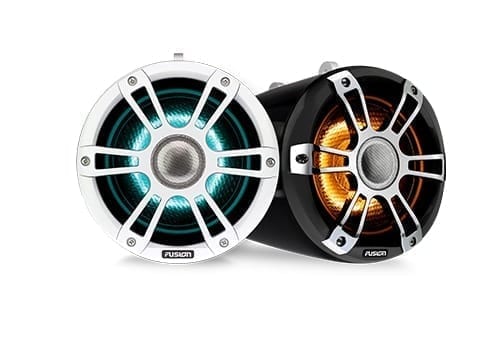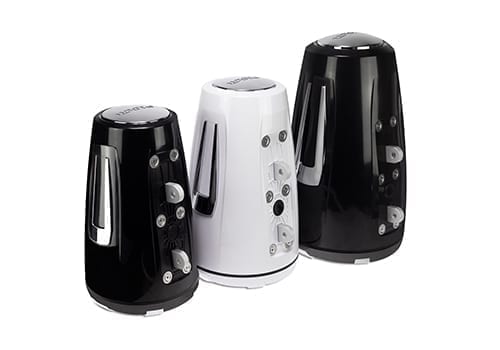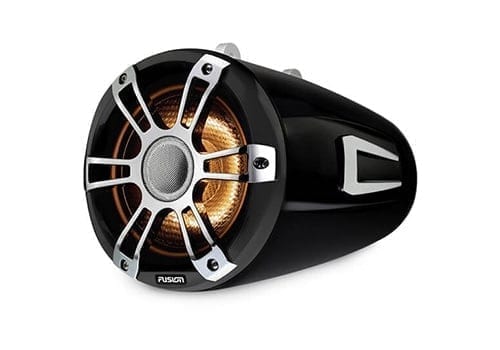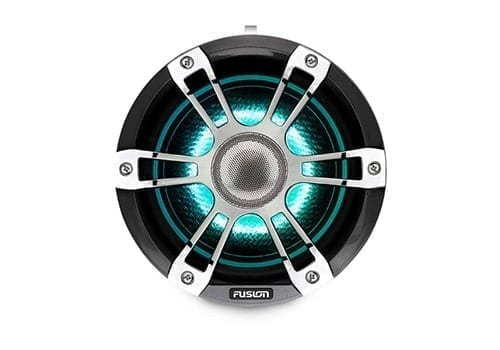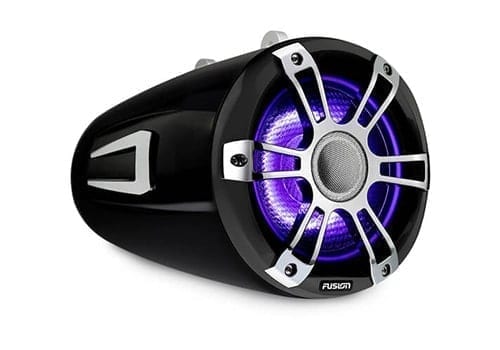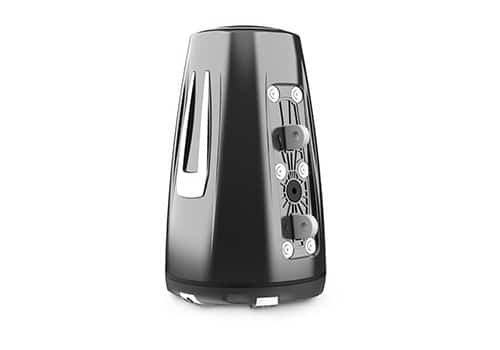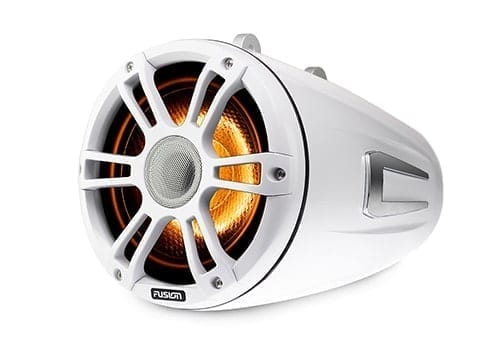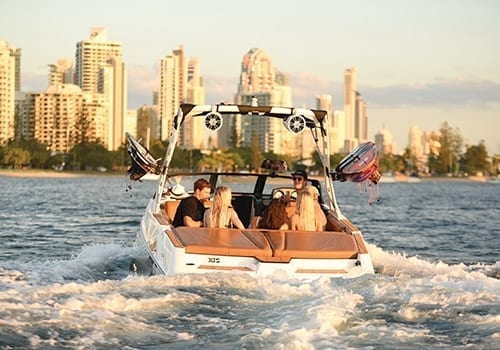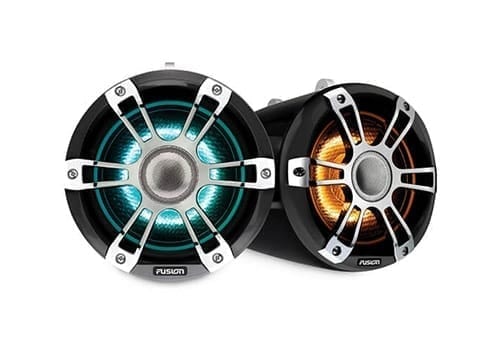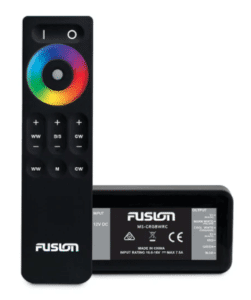Home > Product Installs & Reviews > Product Reviews > Car Speaker Reviews > Fusion Signature Series 3 Tower Speakers Review: First Look
In this article: We'll take a first look at Fusion's brand new Signature Series 3 tower speakers, review their key features and hardware, and provide our own opinion of them along the way.
My previous 2004 Super Air Nautique 210 shipped with two pairs of Fusion's T6.5 tower speakers. An upgrade that was well worth it. It's hard to believe that was 16 years ago now. I kept them on the boat for nearly 11 years until I finally decided to upgrade the entire system.
At the time we purchased the boat, Fusion's towers were a 2-way component setup with the tweeter mounted to the side of the tower speaker's enclosure. LED lighting was in its infancy. I don't even think there was an option for LED lighting at that time (but I may be wrong). It may seem strange today but it was a great-looking setup that sounded fantastic when you were behind the boat. Much has changed since then – speakers, and boats!
In December 2020, Fusion announced the release of the newest line of wakeboard tower speakers – the Signature Series 3. They're essentially a redesign of their predecessor Signature Series speakers and subwoofers that are all designed to work together to bring a well-matched and powerful stereo to nearly all wakeboard boat configurations. We happened to get an early peak at these speakers, and in this review we'll open a brand new pair up, tell you what we think and walk through all of their key features. Note that in our First Look Reviews, we don't install the speakers or cover sound and tuning. Check out our full stereo install on an Axis A22 for more details about the install and performance.
About Fusion
For those of you who may not know, Fusion is now a Garmin brand. In 2014, Garmin announced the acquisition of Fusion Electronics to add to it's growing line of marine and automotive products. Fusion was founded in New Zealand in 1998 by Sir Peter Maire as a home grown car audio brand and grew to be a global audio brand. As Fusion grew, they entered into the marine world extending their established audio tech into the world of boats. With over two decades of engineering and designing automotive and marine electronics, Fusion's focus is quality and acoustic excellence.
Unboxing & First Impressions
First off, let's talk about the Signature Series 3 tower speakers while they're still in the box. The price point may give this away before you even look or get your hands on a pair of them, but Fusion's Series 3 speakers were designed with two things in mind:
- Premium Quality – in the marine world this is absolutely necessary if you want your expensive products to last from season to season.
- Premium Design – nobody wants to throw a terrible looking and sounding stereo into their boat, whether it's a new G23 or an old pontoon.
The Signature Series 3 speakers are a premium set of tower speakers and that's the feel you get when you first see and open up the box. They're neatly wrapped in independent cloth sacks, neatly tied at the top. When you pull them from the box, they're not too heavy. Unlike the Kicker KMTC or Wet Sounds REVs, the Signature Series 3 towers don't come in the box with the mounting mechanism so you'll notice wire that looks like it sticks out of the speaker without purpose. This is because there are three options for mounting – fixed, swivel and surface mounted. Depending on your application, you will need to order them separately and install them onto the speakers. Check out the Swivel Clamps section below to read more about the swiveling mechanism offered by Fusion.
Buy the Signature Series 3 8.8″
Recent Reviews & Articles
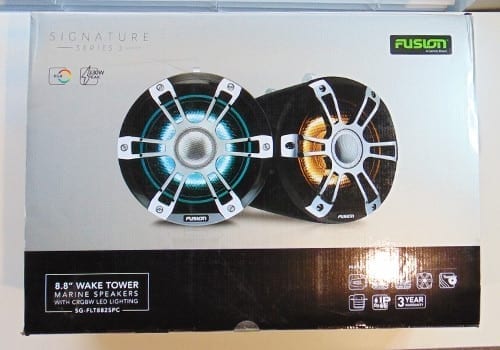
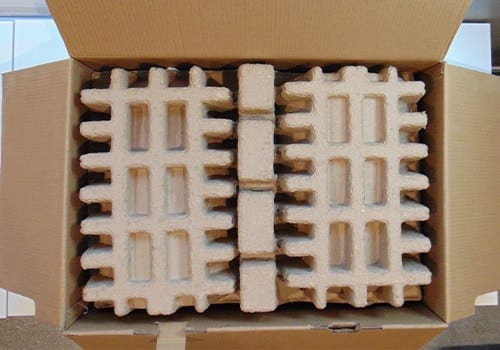
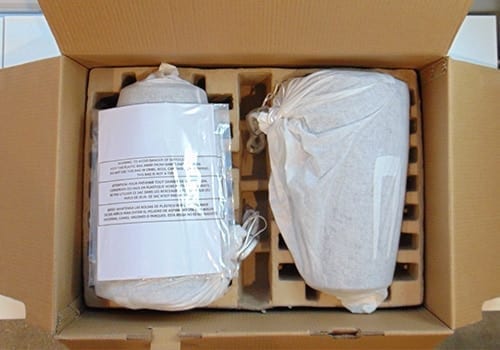
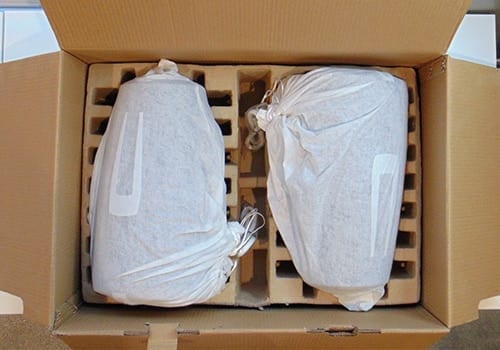
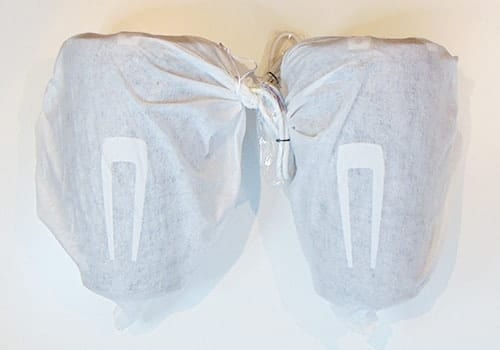
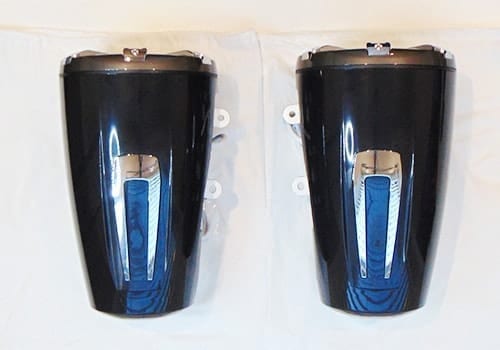
At the front of the tower speaker you'll see a coaxial style, two-way speaker with a chrome/white or chrome/black grille (depending on what you order). The grilles are clean and stylish but not as aggressive as a Wet Sounds or Kicker design grille. They feel strong, which is important – I picture a wake surfboard getting brought back into the boat and clipping one of the grilles of these speakers. The grilles on these speakers will take a blow while protecting the cone behind.
Behind the grille and tweeter you'll see the carbon fiber-looking, polypropylene composite woven driver. Fusion is actually one of the few manufacturers that makes three sizes of tower speakers – 6.5″, 7.7″, 8.8″. In this review we're looking at the 8.8″ which is a great full-range option speaker. It's important to note that the size on these speakers is measured from the outer diameter of the speaker's enclosure, not the diameter of the speaker within. The actual speaker size in this 8.8″ is about 7.5″. Some manufacturers use the outer diameter as the measurement while others use the speaker diameter measurement.
The Signature Series 3 tower speaker enclosure reminds me a lot like the JL M6 – longer, more torpedo style enclosures. But there's a reason why – these speakers aren't HLCD (horn loaded compression driver). Fusion (and JL) needed to design and tune their enclosures precisely to the speaker drivers that they use to produce longer throw and full sounding speakers at high volumes. Further in our article we'll talk about this more. The enclosure feels a little lighter than I would expect, but I have zero concern about the integrity. I've held some heavy tower speakers. To the point where if a few of them were mounted on a tower, combined with a heavy day of chop, might be cause for concern. For reference these speakers weighed about 10lb 1oz (without the mounting mechanism) when I weighed them on my own scale, while the Wet Sounds REV 10 weighs 14.8lbs and the REV 8 weights about 12.8lbs. You can read more about the enclosure tech further in the article.
On the side of the enclosure is a nice accent piece. And on the very rear side of the enclosure another complementary chrome accent piece with Fusion's logo that can be adjusted so that the logo is level no matter what angle you mount your speaker at. If your boat has chrome accents, these speakers will really complement the look and style.
All-in-all, the Signature Series 3 look great, feel great and in general pass the eye test!
What's In the Box:
- Two 2-way Marine speakers
- 2 grilles (fixed)
- Installation instructions (English/ French/ Italian/ German/ Spanish/ Portuguese/ Danish/ Dutch/ Finnish/ Norwegian/ Swedish/ Chinese)
- Safety and Product information
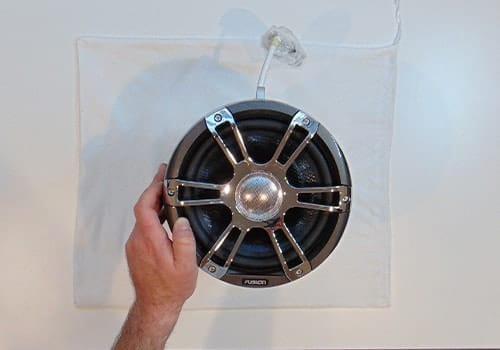
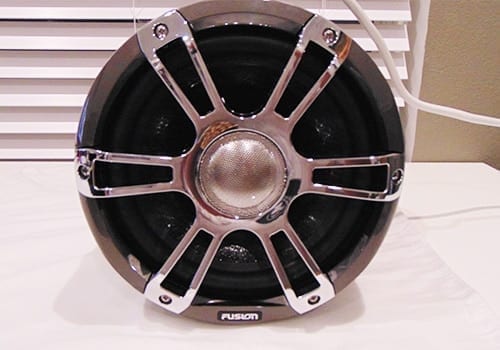
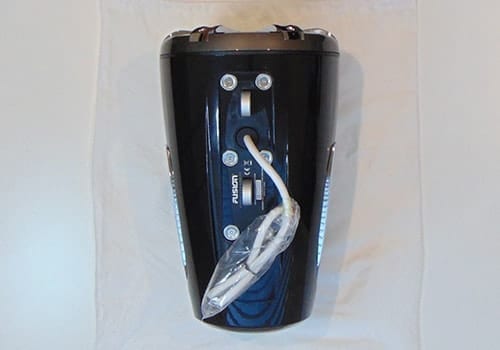
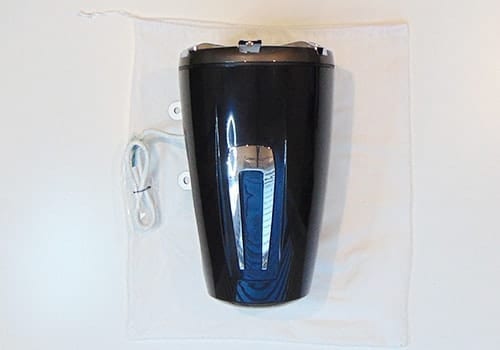
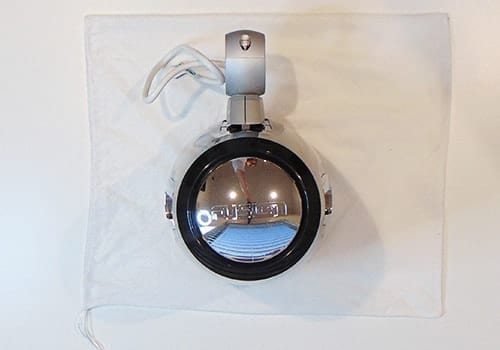
Sound Features – Tweeter, Cone and Enclosure
The Series 3 towers are 2-way coaxial speakers that are engineered to pump higher volume and fuller sound at longer distances in the marine environment than traditional automotive coaxials. These three things alone are probably the toughest combination of requirements for a speaker apart from being fully submerged in water. JL Audio's M6 and Fusion's Series 3 towers share a very similar design, construction and overall performance goals, while other tower speakers like Wet Sounds REVs and Kicker's KMTCs are what's called Horn Loaded Compression Driver (HLCD) speakers. The difference is in the design of the tweeter, and the sound at long distances, which requires a different style enclosure. Coaxial designs are typically fuller-sounding and don't suffer from the harshness at high volumes that HLCD speakers do. They're great for wake surfing, coves and can be heard when you're wakeboarding or further from the boat too.
HLCD speakers are designed for long distance. They're more directional sound, so they might sound louder when you're directly behind them which which makes them a little better for further distances like wakeboarding when you're 65ft behind the boat. But, tuning will make the difference with HLCD speakers and it's very common to hear these types of speakers over-pronounce the high frequencies.
Let's dive a little more into the audio tech and features of these towers.
Tweeters
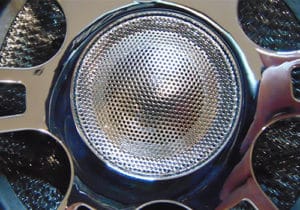
Like I just mentioned, the Series 3 speakers are a coaxial design, which basically means the woofer and the tweeter share the same space in some capacity. You can read a little more about coaxials and component speakers here if you'd like. In Fusion's case, they're mounted within the grille, directly in front of the woofer. This is the most common coaxial design. What's important to note is that the tweeter does not share the surface area of the woofer, meaning it's not mounted directly in the center of the woofer itself. Rather, it's suspended in front of it so that the woofer retains its full surface area.
The tweeter itself is a silk dome tweeter. All that means is that the tweeters will sound a little smoother and less harsh than that of an aluminum or titanium dome tweeter. Back to the harshness topic – a softer dome like the silk dome helps to prevent harsh sounding speakers without necessarily sacrificing sound or quality.
The Woofer
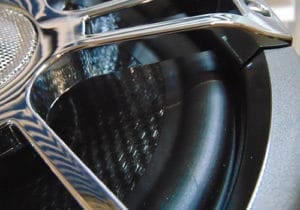
Fusion's Signature Series 3 tower speakers feature a proprietary technology called CURV. Per Fusion, “CURV is a woven fiber composite that is heat pressed to form a lighter and stronger cone. This delivers greater sound definition and higher output while providing increased protection from marine conditions”.
I have not had much personal experience with this woofer, nor the CURV technology. It looks like a woven carbon fiber woofer at first glance. I can say that woven cones are typically made in an effort to maximize strength, resilience while minimizing weight. In fact, Fusion claims it's 30% lighter than a traditional mica-filled polypropylene cone.
CURV uses polypropylene, which is a very common material used to make cones, just not very commonly used woven. It's resistant to the elements – UV, high temperature and moisture – which is crucial for the marine application (obviously). They're more expensive to manufacture as well so there's definitely a reason why they would use this tech in these speakers. They essentially take polypropylene and draw it out into very fine tape, weave it and then heat treat it to strengthen it. To be honest, only the sound test will tell you how this new tech will perform. Check back when we install these for more information about how tuned and tested these out.
Structure & Enclosure
The enclosure structures on wakeboard tower speakers are specifically designed to generate higher volume at further distances while minimizing distorting. The enclosure has a huge impact on the efficiency and overall sound of the speaker within. I touched on this a little bit, but the giveaway to this fact is looking at the difference between an HLCD enclosure which is typically shorter and more stout by design, and that of a well-designed coaxial tower speaker which is typically longer and more tubular looking.
The material that's used in the enclosure is very important as well, especially the surface treatment. A few seasons in the sun and moisture will put any material to the test. Fading, delaminating and rusting (e.g. the older metal chrome tower enclosures) are all symptoms of the extreme environment these speakers get put through. The Signature Series 3 enclosures are made from a polypropylene material as well which is by nature UV resistant. I'm curious as to how they will hold up after a few years of sun though.
The Swivel Clamps
All three type of clamps – fixed, deck/surface mount and and swivel clamps – are sold separately from the tower speakers. Without them, you can't hang or mount your speakers. For this review, we chose to take a look at the swivel clamp brackets.
I have to admit these are probably one of my favorite looking brackets. All of the mounts are made from machined aluminum and appear to be an anodized gray color. It looks sleek and modern and matches the style of the speakers really well. Although, I'm surprised that with the chrome accents on the speaker grilles and the enclosures that they don't offer a polished or chrome look as well. The brackets are pretty universal, in that they come with plastic inserts that enable the brackets to mount to towers between 1.31 inches and 2.5 inches in diameter.
One of the things I'm always looking at with clamps is their hang height. Bigger tower speakers, especially on older boats, tend to become head bangers when you get back into the boat so the lower they hang, the more likely you are to give yourself a shiner on the way back in. The total height of the swivel clamps is 4 3/4 inches but if you were to look at the distance from the center of the bar to the top of the speaker it'd be 3 1/8 inches which is comparable to other swivel clamps (note this is the distance from the center of the tower bar to the top of the 8.8″ speaker so the total hang height would be around 12 inches). The swivel clamp hangs a full inch lower than the fixed clamps though so if you're looking to tuck the speakers as high into the tower as possible, fixed clamps are going to get you about an inch closer to the tower.
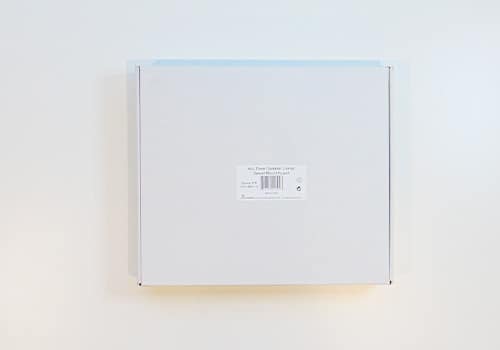
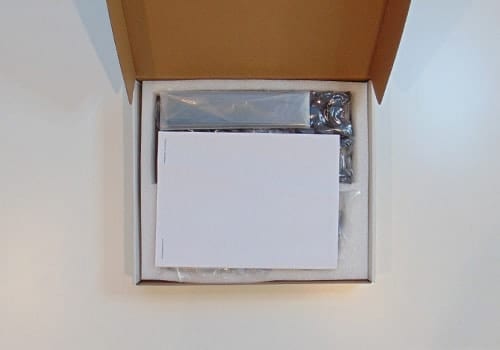
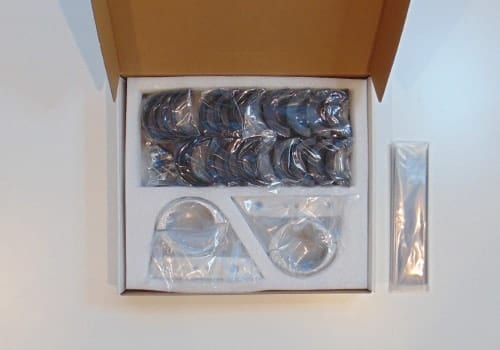
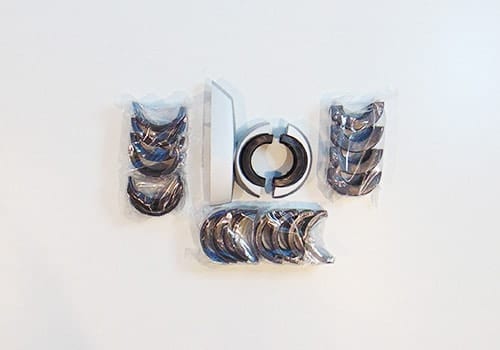
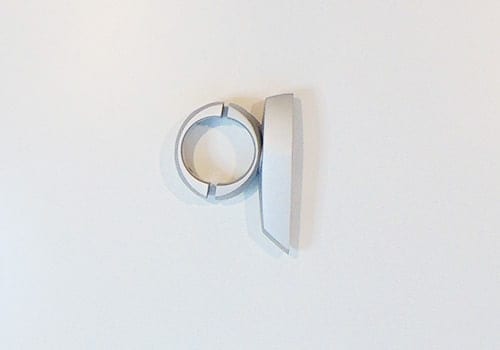
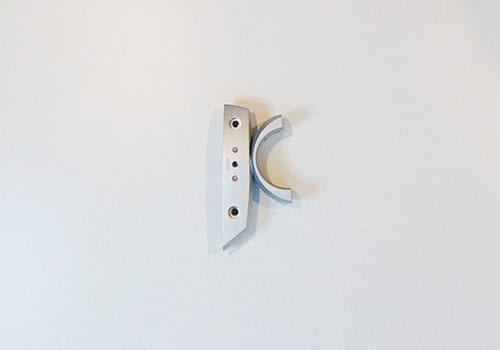
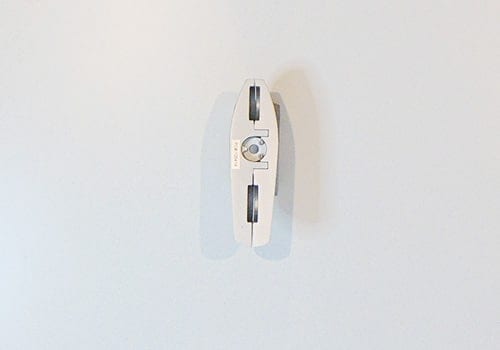
In terms of the mechanism itself, Fusion kept it simple – The top of the clamp mounts to the tower, in the middle is a swivel mechanism that swivels about 110-120 degrees in one direction and about 90 degrees in the other. Out of the box it does not turn 180 degrees, however there are two allen screws in the mechanism that can be removed to give you the rotation that you'd like depending on which side of the boat the speaker is on and which way you'd like to rotate the speaker. In the instructions, Fusion details how to do this. Also in the swivel mechanism is a locking nut via another allen screw that will fix the speaker in place when tightened.
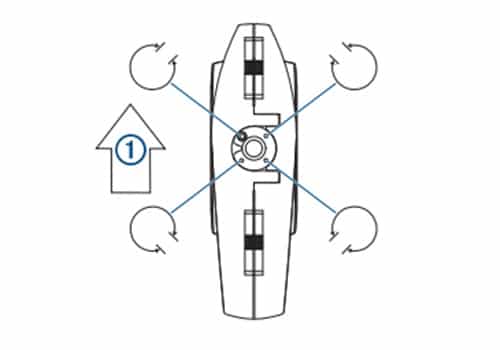
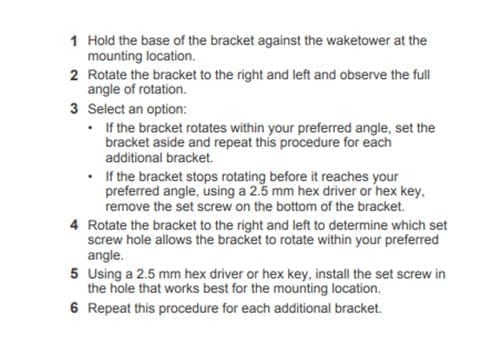
Finally, on the bottom side of the swivel is the surface that mounts to your speaker via two hefty screws. The simplicity of this system is attractive but it's worth noting that these swivels do not allow you to disconnect or pull the speakers from the boat without dismounting them entirely. And if you did want to enable that, you'll need to wire in a deutch plug or similar marine grade plug to disconnect the wires because there is no disconnectable wire plug/harness with the speaker or clamps. That means, without a plug you'd have to cut the wires to remove them from your tower. Most people leave them on the tower, but the ability to pull them in the case of an emergency or convenience is a nice feature that comes with other tower speaker manufacturers.
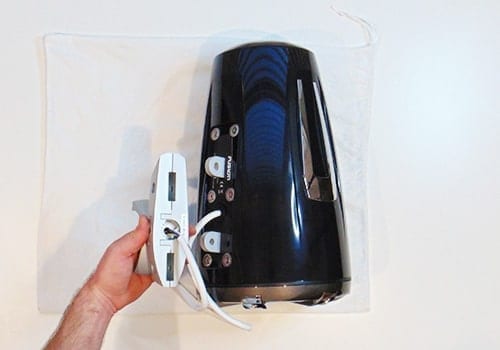
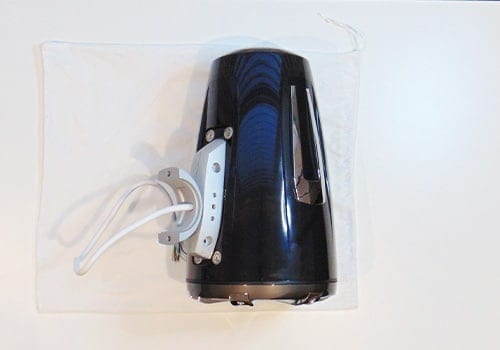
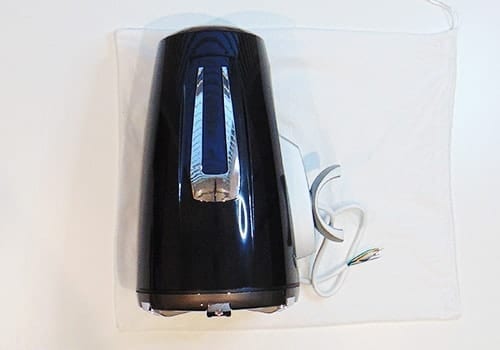
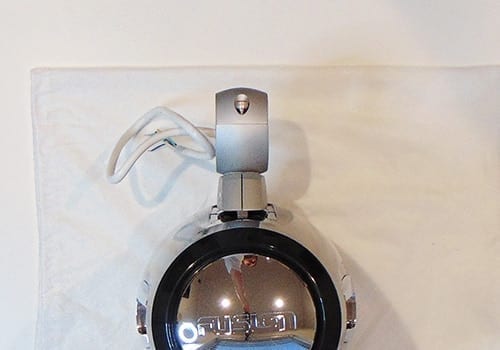
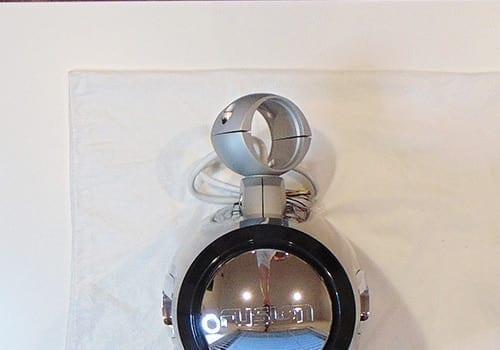
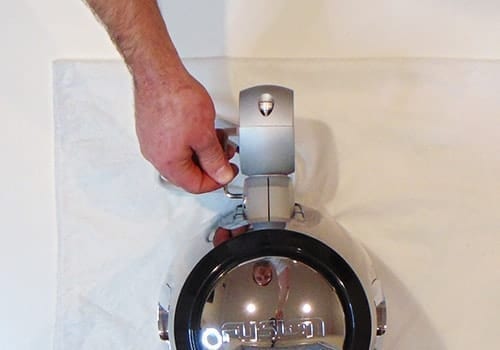
For wiring, the Signature Series 3 speakers come with CRGBW LED (we'll get into this a little further), along with the speaker power and ground which means they have a total of 8 wires. The wire simply threads directly through the bottom of the clamp and out where the speaker mounts to the tower where you'll connect to the wiring that's in your tower (or wherever you're mounting them).
Marine-Specific Features
I touched on some of the marine features throughout the article when it was relevant but let me summarize some of the key features Fusion calls out in their tower speakers.
UV Protection:
- CURV cone technology with woven polypropylene fiber composite material.
- Speaker enclosures that are UV-resistant inhibitor to prevent fading or discoloring.
Corrosion & Water Resistant Protection:
- CURV cone technology with woven polypropylene fiber composite material.
- Stainless steel and aluminum hardware
- ISO12216 compliant design – which means it has been tested to the international standards for pressure and water tightness.
- IP65 Rating – IP65 is protection from water, dust, salt, fog and UV.
New CRGBW LED Lighting
One of the differentiators between these tower speakers and the others on the market today is their LED lighting feature. Fusion introduced a new enhanced lighting system that's an industry first. For the folks reading this that are looking for the best, most customized look on the water at night this is for you!
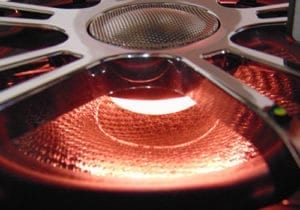
Fusion is calling the Series 3's lighting CRGBW. Normal LED lighting on speakers like JL, Kicker, Wet Sounds and etc are a blend of 3 LED colors – red, green and blue (RGB). Fusion added two additional ‘colors' to the mix for a total of 5 LED colors – cool white, red, green, blue, warm white. The LEDs are mounted to the back side of the tweeter/grille to fire the light towards the cone of the speaker.
Now, you can pretty much get all of the colors that you might think you want with a standard RGB LED lighting, just look at the M6 series from JL. But what the added warm and cool whites will do is really enhance the spectrum and add a much wider range of color with richer color tones than the traditional RGB. We tested the colors out here to show you. Let's start by walking through some of the standard colors without the cool and warm whites added. For the sake of my time (and yours) I went through some of the key ones but you can really go through an even broader spectrum of colors. Take a look:
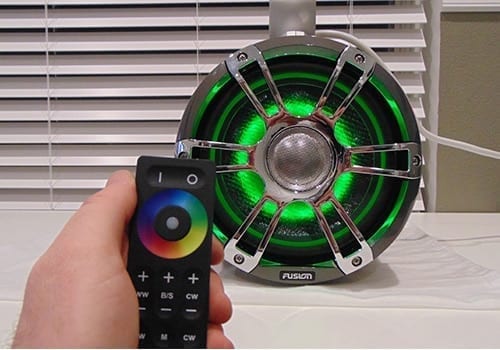
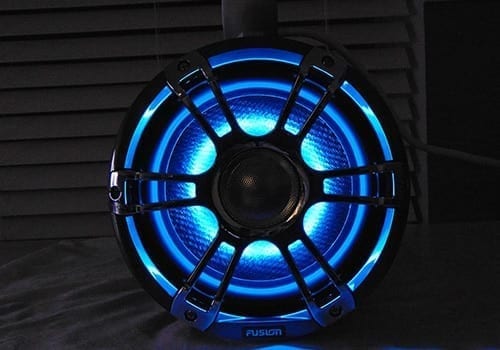
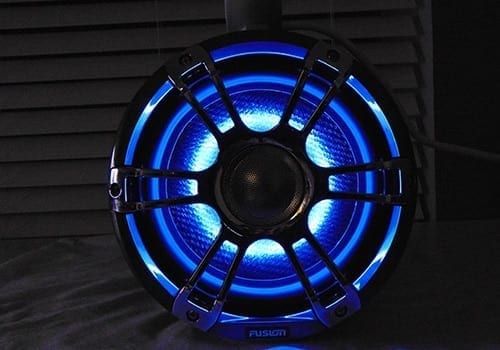
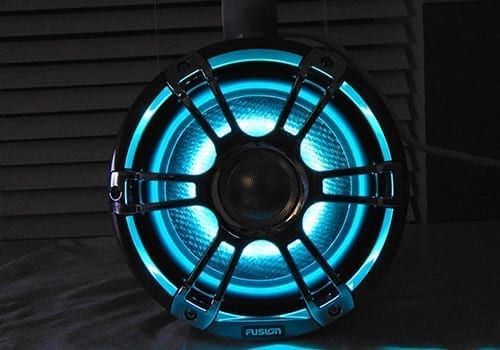
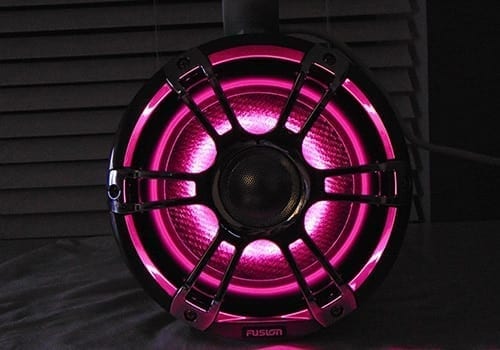
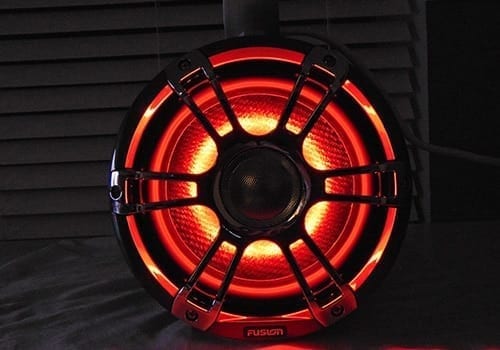
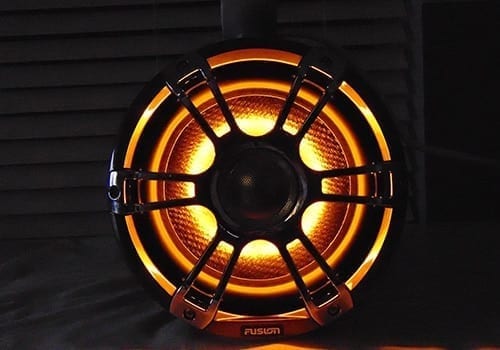
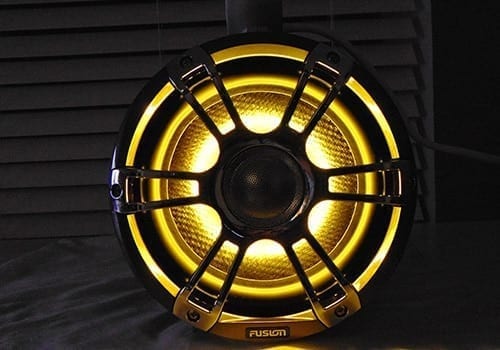
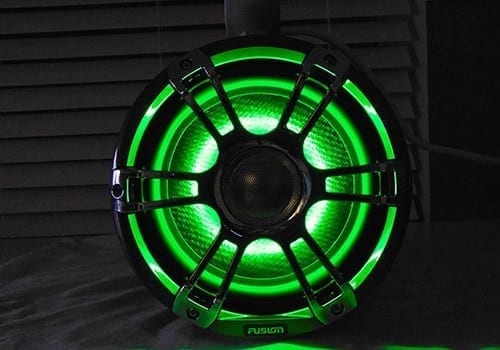
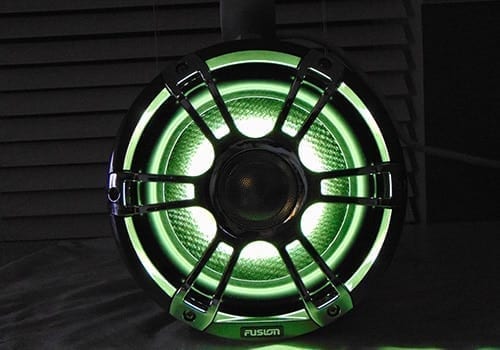
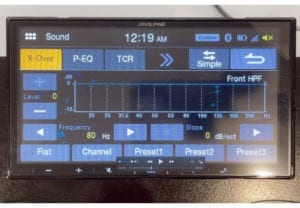
Using Fusion's CRGBW wireless lighting remote and module, I took the speaker through the entire range of colors. The LED module very straight forward – it tells you which color speaker LED wire goes where. Simply wire it up to the speakers and then to a 12v power and ground. Note that you'll have to combine all of the LED wires from all speakers into one, then connect it to this module. For example, if you have 6 interior speakers, two tower speakers and subwoofer that all have the LED functionality, you'll technically have 9 of each colored wire (e.g. turquoise) to combine into one. Once they're combined you can secure them to the module.
The wireless lighting remote really makes it easy to tune the color to what you want. You can chose between 25 preconfigured lighting patterns or choose your own custom colors in a static or dynamic mode. It's touch control and color select wheel make it quick and intuitive to scroll through the spectrum and stop when you find something you like. This is nice if you're really looking for a specific color to match the interior or dash color of your boat.
To walk you through the remote image here, at the top you have the power control – turn the lights on and off. Below that is the color spectrum that you simply tap or scroll to get the color you want and the speakers will respond. Below the spectrum is where it may get a little confusing but once you figure it out it's smooth sailing.
On the bottom left you have the Warm White control. Click on the WW button to turn the warm white on, and then control the intensity of the warm white with the + and -. In the middle, use the “M” to turn on a cycling range of colors and the + and – above the “M” to adjust the speed at which the lights cycle through colors. On the right, the “CW” will turn on the cool white and the “CW” + and – will control the intensity of the cool white.
Here's what's important to note:
- With cool white (CW) and warm white (WW) turned completely off, you'll get your very dark, vibrant and traditional RGB colors.
- Cool white (CW) and warm white (WW) are additive to the traditional RGB colors. Think of it as turning another light bulb on that will change the look and shade of the traditional RGB colors.
- You can add in cool white (CW) and warm white (WW) separately or together.
- Depending on the intensity of each (or both), cool white (CW) and warm white (WW) will alter the shade of color – this is what sets this new CRGBW feature apart from it's competitors.
I was surprised at how wide the spectrum of colors really is. You can really get almost any color you want when you combine a normal RGB available color with the cool and warm whites. I also wasn't sure how well the LED would reflect off of the woven cones but they look great. I think a more reflective cone like Kicker's KMTC cone would be a boost in how impactful the colors are though.
And like I mentioned earlier, the lighting module will connect to all of your speakers at once if you want, syncing up all of the speaker LEDs together to make a pretty incredible lighting experience if you have all interiors, tower speakers and subwoofer with CRGBW LED functionality.
All-in-all, I have to say this is a pretty cool feature if you like customization options. Here's a quick example of how the cool and warm white options works using a base color of red:
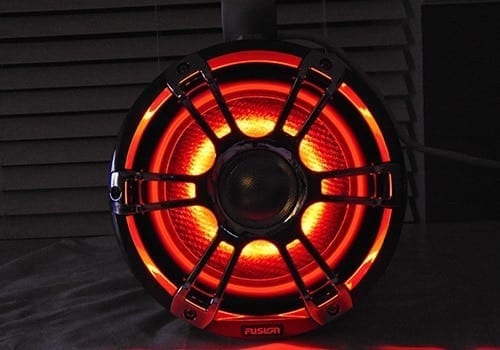
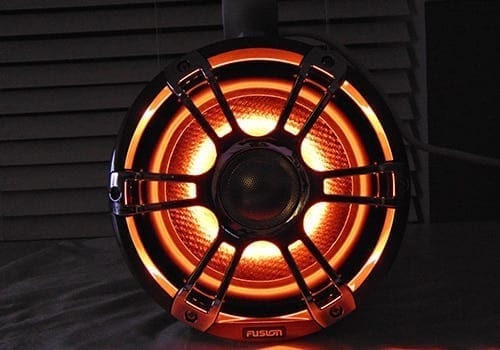
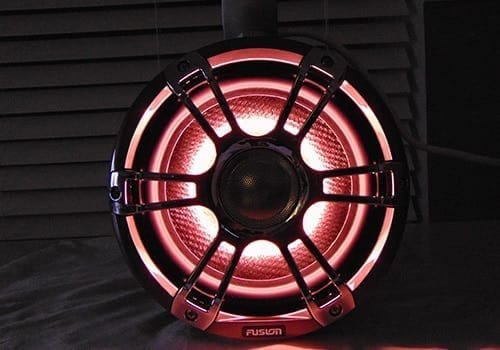
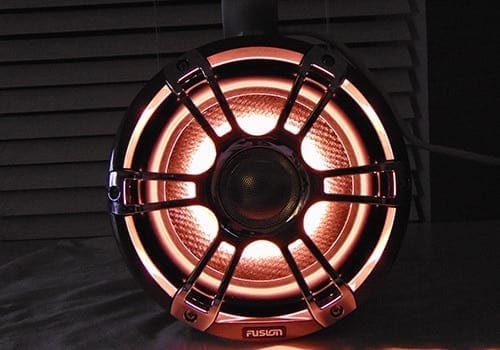
Signature Series 3 Tower Speaker Highlights & Specs
Here's a breakdown of all of the speaker specs for the three sizes:
- Physical dimensions (Diameter x Depth)
- 8.8″: 8.82″ x 15.16″ (224 x 385 mm)
- 7.7″: 7.72″ x 12.91″ (196 x 328 mm)
- 6.5″: 6.93″ x 11.97″ (176 x 304 mm)
- Water and dust rating IP65
- Configuration coaxial
- Speaker size 6.5″, 7.7″ and 8.8″
Peak power (Watts)- 8.8″: 330 W
- 7.7″: 280 W
- 6.5″: 230 W
- RMS power (Watts)
- 8.8″: 130 W
- 7.7″: 100 W
- 6.5″: 75 W
- Sensitivity (1 W / 1 m)
- 8.8″: 91 dB
- 7.7″: 91 dB
- 6.5″: 90 dB
- Frequency response
- 8.8″: 50 Hz-20 kHz
- 7.7″: 60 Hz-22 kHz
- 6.5″: 70 Hz-22 kHz
- Nominal impedance 4 ohms
- Recommended amplifier power (RMS)
- 8.8″: 25-140 W/Ch
- 7.7″: 25-120 W/Ch
- 6.5″: 30-90 W/Ch
- LED lighting yes (CRGBW)
- LED supply voltage 10.8-16 VDC
- LED load current @ 14.4 VDC 300 mA
- Operating temperature range 32° to 122° F (0° to 50° C)
- Voice coil diameter
- 8.8″: 1.5″
- 7.7″: 1.4″
- 6.5″: 1.2″
- Cone material CURV cone with rubber surround
- Tweeter type Silk dome
- Compass-safe distance
- 8.8″: 162″ (412 cm)
- 7.7″: 141″ (358 cm)
- 6.5″: 122″ (310 cm)
Conclusion
You can tell Fusion really focused on making a marine-grade tower speaker that will withstand the elements, perform at high levels and bring a level of customization & design that's unmatched on the market right now via their CRGBW LED lighting.
The enclosure design looks stylish and was engineered to maximize the performance of the coaxial speaker. Apart from JL right now, Fusion is the only one with this style enclosure/coaxial speaker combo. I think the grille design is elegant, but my personal preference is a little more aggressive like the REV series from Wet Sounds with a little less chrome. That said, you may love the design and it may match the interior of your boat much better than the look of another tower speaker.
I've said this in other reviews, but to me having at least one pair of swivel clamps on your tower is a must and I think that Fusion nailed the look of it. And if you're not looking to pull your speakers from your tower I also think the design is excellent. If you prefer to remove your speakers when it's raining or in a shady overnight parking lot, these clamps won't give you the flexibility to easily remove your speakers from the tower though.
In terms of power handling, I think the numbers are impressive but again in this First Look review I have not tuned or heard the speakers yet. Check back for our thoughts on sound.
The LED lighting was really a cool feature to mess around with. I only hooked up one speaker but I can picture having the entire boat configured with this CRBGW setup and how powerful it could really be.
Another great pair of wakeboard tower speakers to consider for your next stereo upgrade! Check out the video below for our walkthrough of the speaker features and the CRGBW light demo.
